

Dynamic/science/labs/DichotomousKeyProtocol.pdf. Basic Principles of Genetics: Printable Crossword Puzzle. Fire.biol.wwu.edu/donovan/SciEd491/NaturalSelection.pdf. Genetic Drift Simulation. The Manual Version Choosing a random number Preparing for the manual simulation The set-up Step 1 Step 2 Step 3 Step 4 Step 5 Step 6 << About this simulation | Driftworm Simulation >>

Natural Selection Simulation Using Utensils. Overview - Students will model natural selection by using various utensils to "capture food" Materials (most of these I leech from the dissecting equipment drawer) Bags of beans (northern or lima) Trays for holding the beans Clothespins Plastic spoons, plastic forks, plastic knives Tweezers Any utensil or item can serve as a mouthpart, use your imagination or improvise with available materials.
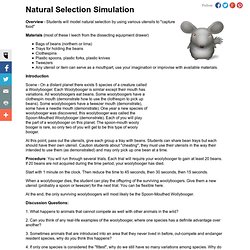
Introduction Scene - On a distant planet there exists 5 species of a creature called a Woolybooger. Each Woolybooger is similar except their mouth has variations. At this point, pass out the utensils, give each group a tray with beans. Evolution.berkeley.edu. Www.lessonplansinc.com/lessonplans/dinosaur_evolution_project.pdf. Www.lessonplansinc.com/lessonplans/natural_selection_evidence_ws.pdf.
Hands-on Activities for Teaching Biology to High School or Middle School Students. By Drs.

Ingrid Waldron and Jennifer Doherty, University of Pennsylvania The expression "hands-on, minds-on" summarizes the philosophy we have incorporated in these activities - namely, that students will learn best if they are actively engaged and if their activities are closely linked to understanding important biological concepts. Many of our activities are explicitly aligned with the Next Generation Science Standards, as indicated by (NGSS) in the descriptions below and the links to the right. Additional information is provided in Summary Tables and in the Teacher Preparation Notes for these activities. To accommodate limited budgets, most of our activities can be carried out with minimum equipment and expense for supplies. Additional resources for teaching biology are available at Minds-on Activities for Teaching Biology. Read More Intro and Biological Molecules Is Yeast Alive? Enzymes Help Us Digest Food(revised, February, 2017) Who Took Jerell's iPod?
More Minds-on Activities. Www.nku.edu/~bowlingb2/NaturalSelectionActivity/LP_1.pdf. Www.sfponline.org/uploads/336/DiffusionLabReport.pdf. Www.thehastingscenter.org/uploadedFiles/Publications/Briefing_Book/stem cells chapter.pdf. The Vaccine Debate. Here's some alarming news: The number of young children who are not fully vaccinated for preventable diseases has been steadily increasing over the last decade.
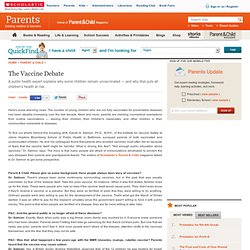
More and more, parents are claiming nonmedical exemptions from routine vaccinations — leaving their children, their children's classmates, and other children in their communities vulnerable to diseases. To find out what's behind this troubling shift, Daniel A. Salmon, Ph.D., M.P.H., of the Institute for Vaccine Safety at Johns Hopkins Bloomberg School of Public Health in Baltimore, surveyed parents of both vaccinated and unvaccinated children.
He and his colleagues found that parents who avoided vaccines most often did so because of fears that the vaccine itself might be harmful. What is driving this fear? Parent & Child: Please give us some background. P&C: And the general public is no longer afraid of these diseases? P&C: Was that what happened a few years ago with the MMR (measles, mumps, rubella) vaccine? BEoN Home. Genetic Science Ethics. Name:__________________________________________ (For each of the scenarios below, discuss with your group the issues, and make a decision)
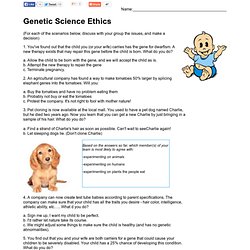
Who Ate the Cheese. Objectives: In this simulation you will examine crime scene evidence to determine who is responsible for eating the Queen's special imported Lindbergher Cheese (yes, the stinky cheese).
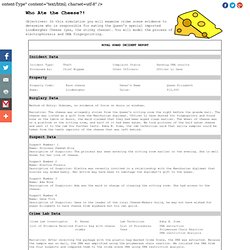
You will model the process of electrophoresis and DNA fingerprinting. Name:_______________________________________________Date:__________ DNA Evidence Evaluation. Morehead Planetarium and Science Center. Biotech Home | Designer Foods | Genetic EngineeringStem Cells Demystified | Biotech Careers ActionBioscience.org This site, which is staffed by the American Institute of Biological Sciences, includes original lessons for middle and high school students on biotechnology and genomics.

Each lesson includes an accompanying article, correlations to the National Science Education Standards, and links for educators and for student research. Chestnut Tree In this environmental biotechnology lab, students use RT-PCR, PCR, restriction enzyme digests, and gel electrophoresis to identify if different fungal cankers from chestnut trees have been infected by a hypovirus and if that hypovirus is wild type or a genetically modified form. DESTINY This site links to high school curriculum designed by Morehead Planetarium and Science Center's DESTINY program. DNA Interactive Lesson. Teachers.sduhsd.net/hmichel/documents/SALI/SALI Year 3/Unit D/Unit D2.pdf. Incomplete dominance. DNA Interactive. TS DNA ModelingTeacher Section. Advanced Preparation The teacher needs to purchase the gummy bears and dinosaurs.
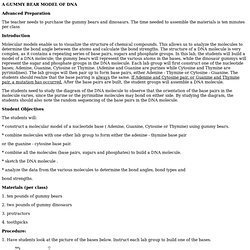
The time needed to assemble the materials is ten minutes per class Introduction Molecular models enable us to visualize the structure of chemical compounds. This allows us to analyze the molecules to determine the bond angle between the atoms and calculate the bond strengths. The students need to study the diagram of the DNA molecule to observe that the orientation of the base pairs in the molecule varies, since the purine or the pyrimidine molecules may bond on either side. Student Objectives The students will: * construct a molecular model of a nucleotide base ( Adenine, Guanine, Cytosine or Thymine) using gummy bears. * combine molecules with one other lab group to form either the adenine - thymine base pair or the guanine - cytosine base pair. * combine all the molecules (base pairs, sugars and phosphates) to build a DNA molecule.
Www.lessonplansinc.com/lessonplans/double_helix_activity.pdf. Www.gov.mb.ca/conservation/sustain/dnadone.pdf. Archives.gadoe.org/DMGetDocument.aspx/EOCT Biology Study Guide August 2008.pdf?p=6CC6799F8C1371F67855208719B00746793113FFB8C45A280DDC416012390B0E. The Ecology WWW Page.